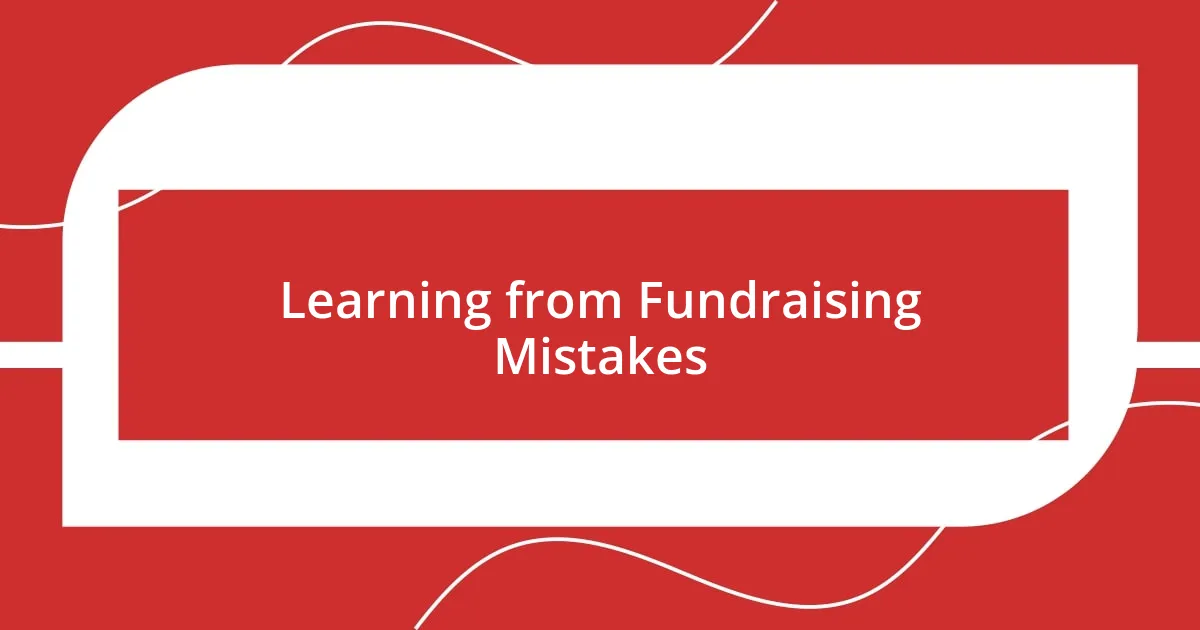Key takeaways:
- Fundraising is about building genuine relationships and engaging emotionally through storytelling.
- Effective strategies involve understanding your audience, setting clear goals, and continuous donor engagement.
- Measuring success goes beyond financial goals; focus on donor retention, engagement, and community impact.
- Learning from mistakes, especially in communication and planning, is essential to improving future fundraising efforts.

Understanding Fundraising Fundamentals
Fundraising fundamentals are really about building genuine relationships with your supporters. I remember my first fundraising event; it wasn’t just about the money raised, but the connections I made. I learned that understanding your audience is key—what drives their generosity? This awareness shapes how you communicate and engages them authentically.
At its core, fundraising is storytelling. It’s about sharing narratives that resonate with potential donors. One time, I shared a heartfelt story about a beneficiary’s journey, and the room fell silent. That emotional connection sparked an overwhelming response, proving that when people relate to a story, they are more likely to contribute. Have you ever thought about how your own experiences can amplify your fundraising efforts?
Then there’s the importance of clarity in your message. When I first began, my attempts to over-explain the cause often left donors confused. I learned to simplify my message—clear, concise, and impactful. This strategy not only attracted more attention but also made it easier for donors to understand how their contributions could make a difference. So, I ask you—are you making your fundraising message as clear as it could be?

Developing a Compelling Fundraising Strategy
Developing a compelling fundraising strategy starts with a clear understanding of your goals. I once sat down with my team to outline our objectives for a major campaign. We recognized that having specific, measurable targets not only aligned our efforts but also inspired our supporters. When donors see a defined purpose, such as funding a specific project, they’re more likely to feel connected and motivated to contribute.
To create an effective strategy, consider these key elements:
- Know Your Audience: Who are your potential donors? What causes resonate with them?
- Craft Your Narrative: Develop a compelling story that illustrates the impact of their donations.
- Set Clear Goals: Define what success looks like for your campaign, including financial and community outcomes.
- Choose the Right Channels: Identify the best platforms to reach your supporters, whether through social media, events, or direct mail.
- Engage Continuously: Keep your donors updated with progress, celebrating milestones along the way.
Reflecting on my own experiences, I’ve found that when I focus on these elements, the strategy begins to take shape, and the passion for the cause becomes contagious.

Building Strong Donor Relationships
Building strong donor relationships is crucial in fundraising, and I genuinely believe it all starts with trust. Early in my journey, I reached out to a small group of potential donors, not to ask for money but to listen to their thoughts on the cause. This humble approach opened doors I never expected. I realized that people appreciate being heard. It’s amazing how simple conversations can lay the groundwork for lasting partnerships. What have you experienced with donor interactions that made a difference?
Another key aspect is personalization. I recall a donor who contributed modestly but consistently to our campaigns. Rather than overlooking them, I took the time to send a personalized thank-you note sharing the tangible impact of their donation. To my surprise, that small gesture led to them increasing their donations over the following years. It confirmed my belief that every donor, regardless of the size of their contribution, deserves recognition and appreciation. How do you show gratitude towards your supporters in a meaningful way?
Keeping communication open is equally vital. I once implemented monthly updates through newsletters, showcasing not just accomplishments but also the challenges we faced. This transparency fostered a sense of community among donors, encouraging them to be part of the solution. They felt connected, not just as contributors but as vital stakeholders in our mission. Have you thought about how regular communication could strengthen your fundraising efforts?
| Key Practices | Impact |
|---|---|
| Trust Building | Establishes a foundation for lasting relationships |
| Personalization | Increases donor loyalty and engagement |
| Open Communication | Creates a sense of community and shared purpose |

Effective Communication Techniques
Effective communication in fundraising is about more than just sending messages; it’s about creating genuine connections. I recall once crafting a heartfelt email to our supporters, detailing a donor’s story and the transformative impact their contribution made on a local family. The responses we received were overwhelmingly positive, with many expressing how personally they felt tied to our mission after reading it. Isn’t it fascinating how storytelling engages people on an emotional level, turning them from passive readers into active supporters?
Another technique I’ve found invaluable is using visuals in communication. During a fundraising campaign, our team designed infographics that laid out our goals and the expected outcomes in a visually compelling way. The increase in donor engagement was tremendous. People often absorb information better when they can see it represented visually, don’t you think? Making complex data easily understandable can simplify their decision-making process and make them feel more involved.
I also believe in the power of two-way communication. After a fundraising event, I took the time to reach out to attendees, inviting them to share their thoughts and feelings about the evening. Many of them shared insights that helped shape our future initiatives. This exchange not only made them feel valued but also provided us with deeper insights into what resonates with our community. How often do you engage your supporters in this way? Opening the floor to dialogue builds a sense of ownership and can spark new ideas for your fundraising efforts.

Utilizing Digital Fundraising Tools
Utilizing digital tools in fundraising has dramatically changed how we connect with donors. I remember one specific campaign where we turned to social media to reach a wider audience. By sharing captivating stories and short videos, we saw donations come in from people I had never met before. Isn’t it incredible how a simple post can transcend geographical boundaries and turn strangers into supporters?
Another experience I had involved using crowdfunding platforms. We launched a project on one of these sites and, to my surprise, the initial momentum came from small donations that quickly added up. Watching the donation bar climb with each notification was exhilarating, and it reminded me that every little bit counts. Have you ever experienced the thrill of realizing your community’s collective power simply through digital engagement?
I also discovered the importance of data analytics in digital fundraising. After analyzing our previous campaigns, I figured out which messages resonated best with our audience. That insight allowed us to tailor our future communications for greater impact. When you truly understand what your donors respond to, it feels like unlocking a new level in your strategy. How do you utilize analytics to refine your approach? Embracing these digital tools has truly transformed my fundraising journey, making it not just more efficient, but also more rewarding.

Measuring Fundraising Success
To gauge fundraising success, I’ve learned that metrics should go beyond just the amount of money raised. For instance, I once analyzed a campaign where we exceeded our financial goal but realized donor retention had actually decreased. It struck me how vital it is to track not just immediate funds but also the long-term relationships with supporters. Have you ever stopped to look at your donor lifecycle rather than just the short-term wins?
Another key measure for me has been donor engagement rates. In one campaign, I implemented follow-up surveys to see how our supporters felt after contributing. The feedback was illuminating and provided insights into their emotional connection to our cause. Understanding that sentiment can shape future campaigns in ways raw numbers never could. What insights could you glean from engaging directly with your supporters post-campaign?
Lastly, I prioritize setting specific goals tied to our mission. During a community outreach event, we aimed to raise awareness rather than just funds. By the end, we gathered a wealth of information about our community’s needs and interests along with donations. It became clear that measuring success isn’t solely about dollar signs; it’s also about the impact we create. Isn’t it powerful when the real success indicators reflect the heart of our mission?

Learning from Fundraising Mistakes
I’ve made plenty of mistakes in my fundraising journey, and each one has been a crucial learning experience. I remember a campaign where we overshot our budget but didn’t adequately plan for expenses. In the end, we were left with a beautiful event but a significant financial shortfall. It’s amazing to think how careful pre-planning could have avoided that pitfall, right? Have you considered the importance of a well-rounded budget in your campaigns?
Another lesson I gathered involved donor communication. Early on, I neglected to follow up with donors after a successful campaign, believing they would just know how appreciated they were. The silence, however, led to disengagement. I realized those personal connections matter. A simple thank-you call or a heartfelt email can forge bonds that keep your supporters coming back. How do you nurture your relationships with donors post-campaign?
I also learned the hard way not to underestimate the power of storytelling. In a previous project, we focused so much on metrics and goals that we forgot to share the human side of our cause. It wasn’t until a donor mentioned the impact of our personal stories that I understood what we were missing. People connect emotionally with narratives, not just numbers. Isn’t it incredible how sharing a sincere story can skyrocket engagement? Embracing this has changed how I approach fundraising, and I can’t stress enough how inspiring it is to view my work through a lens that emphasizes genuine human connection.















